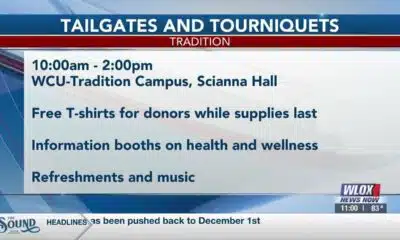News from the South - North Carolina News Feed
Democracy Watch, an Asheville Watchdog biweekly column on local politics, makes its debut • Asheville Watchdog
Although 2025 isn’t an election year for North Carolina voters, it is certainly a political one. This season is already teeming with activity that may reshape North Carolina’s government, Congress (and through it the White House), and democracy itself. Politics writer Tom Fiedler returns to chronicling who’s doing what in the runup to the election, which will be Nov. 3. We’ve renamed his column from Election Watch to Democracy Watch to capture the stakes of 2026. Look for it every other Wednesday.

There was a time when judicial campaigns were polite affairs, mostly devoid of partisan politics and conducted in the monotones of law school lectures. Now we have Elon Musk, the president’s hatchet man, setting a different example with his bombastic entry into Wisconsin’s recent Supreme Court race, spending his millions to try to win the hearts – and maybe the ballots – of its voters in a futile effort to elect the GOP-backed candidate.
The appearance of the world’s richest man wearing a foam cheesehead cap while dispensing million-dollar checks to voters became the iconic image of that campaign, exceeded in impact only by his candidate’s defeat to a (loud gasps here) liberal jurist.
But the Wisconsin election may prove to be just a warmup for a more raucous, expensive and nasty North Carolina Supreme Court campaign in 2026 propelled by the relentless efforts by the GOP to unseat incumbent Associate Justice Allison Riggs, a Democrat. The Republican in the 2024 race, Appellate Judge Jefferson Griffin, lost by 734 votes, a defeat verified by two meticulous recounts.
Yet Griffin, with state and national GOP backing, refuses to accept that he lost and has tried multiple ways to get thousands of North Carolina voters’ ballots erased despite zero evidence of any wrongdoing. So far Griffin has found allies among all but one other Republican state Supreme Court jurist (more on that below. Earlier this month the state’s high court threw Griffin a lifeline allowing him to continue to try to strip away enough legally cast ballots to reverse his loss.
Notably, these are ballots of military men and women, as well as missionaries, diplomats and others living overseas – many of them registered in Buncombe County, one of Griffin’s principal targets. That effort is ongoing, so stay tuned.

The court’s decision has ripped away whatever pretense its justices may have had to judicial comity. Leading a counter-cry to stop the steal is Associate Justice Anita Earls, a Democrat, who has already pledged to seek re-election next year.
She leaves no doubt as to the foes she intends to target: the four of her GOP colleagues who backed Griffin in the most recent decision.
Earls, a Yale-educated civil rights lawyer, furiously attacked them in a 41-page dissent using language rarely seen in Supreme Court decisions. She blasted holes in the majority’s opinion, showing where it was contrary to both state election law and the state’s constitution.
And she made clear her personal disgust at where their ruling was going, even hinting it bordered on the criminal. Some excerpts:
- “It is no small thing to overturn the results of an election in a democracy by throwing out ballots that were legally cast… Some would call it stealing the election, while others might call it a bloodless coup. But by whatever name, no amount of smoke and mirrors makes it legitimate.”
- “Who are these voters [that the GOP seeks to disqualify]? Active service members and their families, missionaries, exchange students, corporate officers, doctors, lawyers, teachers, diplomats and so many other loyal North Carolinains who deserve to have their votes count.”
- “The majority is willfully blind to the equally fraudulent effect of throwing out the ballots of qualified, made even more pernicious when done under the color of law and by order of court.”
- “[T]his special order … issued with unseemly haste as though quickly ripping the bandage off the deep wound to our democracy will hurt less, marks one the the lowest points of illegitimacy in this Court’s 205 year history.”
- “The majority is opening Pandora’s Box. Tomorrow’s losing candidates for elected office can litigate and relitigate their losses after the election along the same lines as Judge Griffin does today. The right to vote for military and overseas voters is conditional on the whims of losing candidates and the limits of their lawyers’ creativity.”
Her prediction that the case will provide the template for GOP challenges to lost elections explains why the Riggs-Griffin case is drawing national attention by both major parties.
Let’s return to the other outlier among the state Supreme Court’s Republicans: Justice Richard Dietz. Dietz joined the dissent, though in a tone that suggested sadness and disappointment with his GOP colleagues rather than the shared fury of Earls.
He noted that he had held hope that, “When the time came, our state courts would embrace the universally accepted principle that courts cannot change election outcomes by retroactively rewriting the law. I was wrong.
“By every measure,” Dietz wrote, “this is the most impactful election-related court decision our state has seen in decades. It cries out for our full review and for a decisive rejection of this or post hoc judicial tampering in election results.”
Can political opposites attract?
Given the hyperpolarized state of the U.S. House of Representatives, it seems unlikely that a far-right Republican and a far-left Democrat would even share a cab in a thunderstorm. But, to repeat the cliche, politics makes strange … uh … co-sponsors.

Consider a bill co-authored by Chuck Edwards, the Hendersonville conservative who stretches that label about as far to the right as it can go, and Jasmine Crockett, a fiery-tongued Democrat from Dallas who is a favorite target of MAGA world. The bill is the Economic Opportunity for Distressed Communities Act, which aims to entice developers with tax incentives to buy and revitalize hazardous sites for a community’s benefit.
Edwards’s public image is that of a nose-to-the-grindstone lawmaker who rarely generates headlines, nor seeks them. Crockett seems to seek and draw fire from MAGA enemies. And she eagerly fires back at such targets as Elon Musk (“I think he’s a crook”) and equally bombastic Republican Rep. Marjorie Taylor Greene (“a bleach blonde, bad build, butch body,” according to Crockett during a congressional hearing).

Still, Edwards told me that he has no problem partnering with Crockett.. “I don’t see eye-to-eye on almost anything [with Crockett] but we share a common interest in wanting to see distressed property rejuvenated.”
Their bill would provide a tax break for developers willing to buy and clean up toxic properties in the greater public interest. Edwards has in mind a 500-acre site formerly occupied by the Ecusta Mill in Transylvania County, which encompasses seven brownfields. He called it a “beautiful piece of land” that, if cleaned up, would attract residential and tourist development.
Crockett said she has sites in her district that can be reclaimed to become parks and playgrounds for urban residents. She said she was “proud to join my colleague in introducing our bill that takes an all-hands-on-deck approach to cleaning our communities.”
Edwards admitted he’s gotten some blowback from local GOP constituents, though mostly “in a comical way.” He offers no apologies. “I can work with anybody as long as it’s to the benefit of North Carolina.”
He also says these kinds of polar-opposite collaborations are more common than thought. “Since I entered Congress there have been 380 bills and amendments passed on a bipartisan basis. But the media tends to zero in on those that tend to spark conflict.”
Asheville Watchdog welcomes thoughtful reader comments about this story, which has been republished on our Facebook page. Please submit your comments there.
Asheville Watchdog is a nonprofit news team producing stories that matter to Asheville and Buncombe County. Tom Fiedler is a Pulitzer Prize-winning political reporter and dean emeritus from Boston University who lives in Asheville. Email him at tfiedler@avlwatchdog.org. The Watchdog’s reporting is made possible by donations from the community. To show your support for this vital public service go to avlwatchdog.org/support-our-publication/.
Related
The post Democracy Watch, an Asheville Watchdog biweekly column on local politics, makes its debut • Asheville Watchdog appeared first on avlwatchdog.org
News from the South - North Carolina News Feed
White House officials hold prayer vigil for Charlie Kirk
SUMMARY: Republican lawmakers, conservative leaders, and Trump administration officials held a prayer vigil and memorial at the Kennedy Center honoring slain activist Charlie Kirk, founder of Turning Point USA. Kirk was killed in Utah, where memorials continue at Utah Valley University and Turning Point USA’s headquarters. Police say 22-year-old Tyler Robinson turned himself in but has not confessed or cooperated. Robinson’s roommate, his boyfriend who is transitioning, is cooperating with authorities. Investigators are examining messages Robinson allegedly sent on Discord joking about the shooting. Robinson faces charges including aggravated murder, obstruction of justice, and felony firearm discharge.
White House officials and Republican lawmakers gathered at the Kennedy Center at 6 p.m. to hold a prayer vigil in remembrance of conservative activist Charlie Kirk.
https://abc11.com/us-world/
Download: https://abc11.com/apps/
Like us on Facebook: https://www.facebook.com/ABC11/
Instagram: https://www.instagram.com/abc11_wtvd/
Threads: https://www.threads.net/@abc11_wtvd
TIKTOK: https://www.tiktok.com/@abc11_eyewitnessnews
News from the South - North Carolina News Feed
Family, friends hold candlelight vigil in honor of Giovanni Pelletier
SUMMARY: Family and friends held a candlelight vigil in Apex to honor Giovanni Pelletier, a Fuquay Varina High School graduate whose body was found last month in a Florida retention pond. Giovanni went missing while visiting family, after reportedly acting erratically and leaving his cousins’ car. Loved ones remembered his infectious smile, laughter, and loyal friendship, expressing how deeply he impacted their lives. His mother shared the family’s ongoing grief and search for answers as authorities continue investigating his death. Despite the sadness, the community’s support has provided comfort. A celebration of life mass is planned in Apex to further commemorate Giovanni’s memory.
“It’s good to know how loved someone is in their community.”
More: https://abc11.com/post/giovanni-pelletier-family-friends-hold-candlelight-vigil-honor-wake-teen-found-dead-florida/17811995/
Download: https://abc11.com/apps/
Like us on Facebook: https://www.facebook.com/ABC11/
Instagram: https://www.instagram.com/abc11_wtvd/
Threads: https://www.threads.net/@abc11_wtvd
TIKTOK: https://www.tiktok.com/@abc11_eyewitnessnews
News from the South - North Carolina News Feed
NC Courage wins 2-1 against Angel City FC
SUMMARY: The North Carolina Courage defeated Angel City FC 2-1 in Cary, ending their unbeaten streak. Monaca scored early at the 6th minute, followed by Bull City native Brianna Pinto’s goal at the 18th minute, securing a 2-0 halftime lead. Angel City intensified in the second half, scoring in the 88th minute, but the Courage held firm defensively to claim victory. Pinto expressed pride in the win, emphasizing the team’s unity and playoff ambitions. Nearly 8,000 fans attended. Coverage continues tonight at 11, alongside college football updates, including the Tar Heels vs. Richmond game live from Chapel Hill.
Saturday’s win was crucial for the Courage as the regular season starts to wind down.
https://abc11.com/post/north-carolina-courage-wins-2-1-angel-city-fc/17810234/
Download: https://abc11.com/apps/
Like us on Facebook: https://www.facebook.com/ABC11/
Instagram: https://www.instagram.com/abc11_wtvd/
Threads: https://www.threads.net/@abc11_wtvd
TIKTOK: https://www.tiktok.com/@abc11_eyewitnessnews
-
News from the South - Kentucky News Feed7 days ago
Lexington man accused of carjacking, firing gun during police chase faces federal firearm charge
-
News from the South - Alabama News Feed6 days ago
Zaxby's Player of the Week: Dylan Jackson, Vigor WR
-
News from the South - Arkansas News Feed7 days ago
Arkansas medical marijuana sales on pace for record year
-
News from the South - Missouri News Feed7 days ago
Local, statewide officials react to Charlie Kirk death after shooting in Utah
-
Local News Video7 days ago
William Carey University holds 'tailgates and tourniquets' blood drive
-
News from the South - North Carolina News Feed5 days ago
What we know about Charlie Kirk shooting suspect, how he was caught
-
Local News6 days ago
US stocks inch to more records as inflation slows and Oracle soars
-
Local News6 days ago
Russian drone incursion in Poland prompts NATO leaders to take stock of bigger threats















































